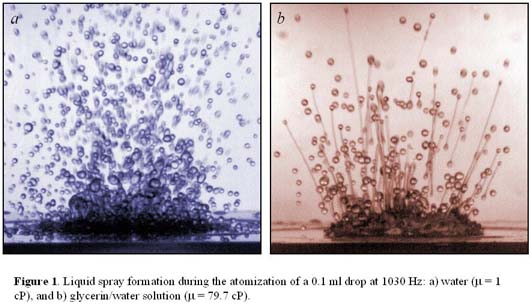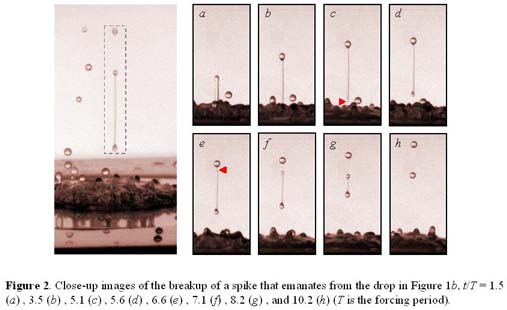
Bojan Vukasinovic home page

A single droplet ejection event is shown in the animated seqence. A 0.1 ml water drop was forced at f = 840 Hz. The sequence of images was recorded at 3000 fps. The field of view is approx. 2 × 2 mm.
These events are apparently initiated by the interplay of the spatial modes on the highly contorted surface of the forced drop. The upward motion of the liquid spike is preceded and directly initiated by the collapse of a free surface crater or depression. The secondary droplet separates from the liquid spike by a capillary pinch-off mechanism. If it has enough momentum, it will then be ejected from the drop.

The breakup mechanisms of the spike and the characteristics of the ensuing spray are strongly influenced by the liquid viscosity. For low-viscosity liquids, the spray droplets are formed by capillary necking and pinching near the tip of a short spike (Figure 1a and the animated sequence above). For higher viscosity liquids, the first breakup occurs near the stem of the spike, with or without a subsequent breakup of the detached, elongated liquid thread (Figure 1b).

A typical breakup of the liquid thread in the high viscosity ejection regime is shown in a sequence of highspeed images in Figure 2. The atomized drop (glycerin-water solution m = 79.7 cP is forced at f = 1030 Hz and the diaphragm acceleration is set to be slightly above the onset of ejection. As the spike elongates (Figures 2a and 2b), the primary breakup occurs at its stem (Figure 2c), and a long liquid thread with an initial upward momentum is formed (Figure 2d. Subsequently, the thread undergoes a secondary breakup at its tip, and a main droplet is ejected (Figure 2e). The remaining liquid thread (Figure 2f) recoils into the single satellite droplet (Figures 2g and 2h). If the initial aspect ratio of the thread is high enough, it may breakup into multiple secondary satellite droplets.
REFERENCES
back to VIDA